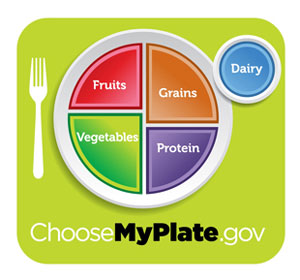Earlier this year the USDA unveiled the MyPlate icon, replacing the MyPyramid graphic in an effort to simplify dietary recommendations for the American public. Yet despite the early excitement surrounding its unveiling, it appears not many Americans are choosing to implement the MyPlate guidelines.
 In fact, most Americans are only meeting the MyPlate guidelines an average of one week out of the year. And this probably isn’t altogether that shocking given that most Americans fail to include vegetables or dairy at most meals. Additionally, the 2025 Dietary Guidelines for Americans, the recommendations visually depicted by the MyPlate icon, often require more than three meals to be eaten each day in order to be achieved which can also prove difficult for individuals who don’t snack in between meals.
In fact, most Americans are only meeting the MyPlate guidelines an average of one week out of the year. And this probably isn’t altogether that shocking given that most Americans fail to include vegetables or dairy at most meals. Additionally, the 2025 Dietary Guidelines for Americans, the recommendations visually depicted by the MyPlate icon, often require more than three meals to be eaten each day in order to be achieved which can also prove difficult for individuals who don’t snack in between meals.
So are the MyPlate guidelines really a diet in disguise that most people can’t stick to for longer than a week? Not exactly. The guidelines behind MyPlate result from years of study and observation of eating behaviors among thousands of Americans. These guidelines outline a lifestyle, not a diet, however without proper guidance they can be just as difficult to stick to.
When implementing the MyPlate guidelines, it’s important to know where to start and to have a little background information on what these guidelines mean. This, of course, requires you to go beyond the plate and develop your own MyPlate-based plan that works over the long-term. And although it’s easy to say this is something you want to do, actually doing it is a lot harder.
Know Where to Start
Instead of tackling the whole MyPlate icon in one overarching attempt, focus on one section at a time and perform your own step-by-step meal plan makeover. Make it unique to your eating preferences and do a little homework. The ChooseMyPlate.gov website is an excellent place to start. There you will find detailed information on each of the five food groups, daily nutrition tips, and interactive tools that can help you track your progress in implementing the MyPlate guidelines.
Using the ‘Right’ Plate
In addition to knowing where to start, it’s also important to be able to visualize the MyPlate guidelines on your own plate. Your plate should be about 10″ in diameter, not 12″. As the years have passed, plate sizes have gone up and you may find that the 10″ plate looks a lot smaller than the ones you use more often at home or while dining out. I assure you, a 10″ plate is a much more appropriate size. Once you have the right-sized plate, you then have to be able to visualize the various food groups that go on or beside it.
Although the MyPlate icon shows a plate with five separate food sections, you need to remember that its all about proportion. Although the plate is divided almost evenly into four different sections, each group does vary slightly in size. This can help you decide which foods are the most important to add to your plate and give you a place to start when planning your meals. Non-starchy vegetables are the most prominent and should be the star of your meal. Next, in order of portion size, add whole grains and then protein. Fruit and dairy should then follow. Just remember that as you add each food group to your plate, the amount of each group you add should continue to get smaller.
Generalizing Nutrition Guidelines
Although the MyPlate guidelines are a great place for many Americans to start, there is no such thing as a one-size-fits-all healthy eating plan. Although the MyPlate icon shows a varied, well-balanced meal plan that is based on years of observation and study, it isn’t necessarily the only way to eat healthy. In fact, many similar plate-style meal plans exist with their own set of guidelines and objectives. On top of that, a wide array of new healthy eating ideas and plans come out every year, making it possible for many individuals to eat well despite their lack of compliance to the MyPlate criterion.
The recommendations behind the MyPlate icon can be very beneficial to individuals who are looking to adopt a healthier lifestyle. Although no one-size-fits-all meal plan exists, the guidelines set forth in this initiative are designed to meet the nutritional needs of the average American. Despite this, simply being aware of the MyPlate icon isn’t enough. An individual looking to utilize these guidelines in an effort to eat better must know how to use it and where to start.
Also Read:
